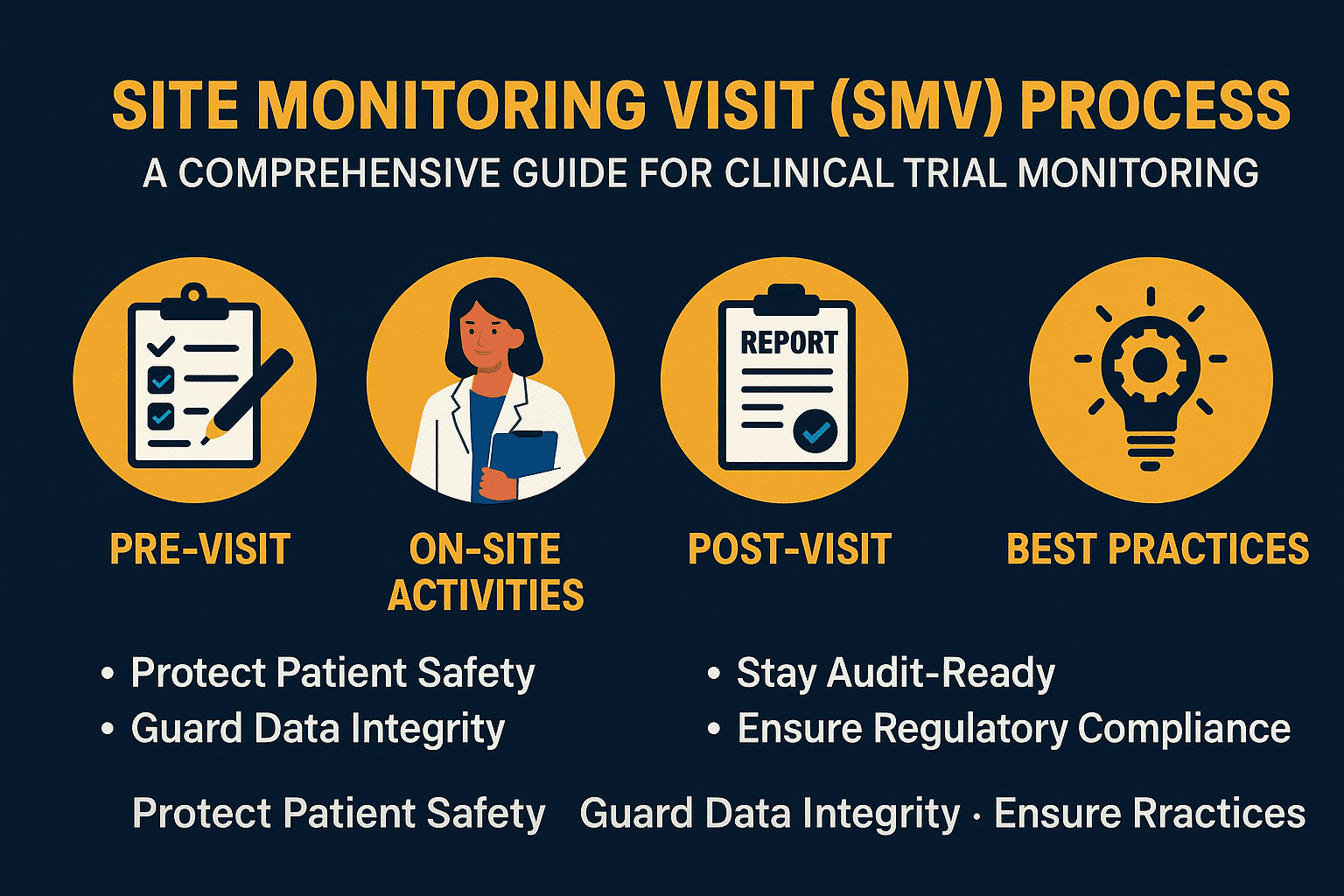Unlock the step-by-step SMV workflow, best practices, and key technical considerations to ensure patient safety, data integrity, and regulatory compliance.

Table of Contents
What Is a Site Monitoring Visit (SMV)?
A Site Monitoring Visit (SMV) is a routine inspection conducted by a Clinical Research Associate (CRA) to verify that a clinical trial site is:
- Conducting the study per protocol and GCP (Good Clinical Practice).
- Maintaining data integrity via Source Data Verification (SDV).
- Protecting participant safety and rights through accurate documentation.
SMV Types & Scheduling
| SMV Type | Timing | Objective |
|---|---|---|
| Site Initiation | Pre-study start | Train site staff, confirm readiness |
| Routine Monitoring | Throughout enrollment (e.g., every 4–8 weeks) | Ongoing compliance & data checks |
| Close-Out | After last patient’s final visit | Archive study documents, reconcile IP |
Scheduling: CRAs and site teams agree on visit dates 2–4 weeks in advance, based on enrollment pace and protocol-specified frequency.
Pre-Visit Preparation
Review Study Documentation
Protocol amendments, IB (Investigator’s Brochure), SOPs.
Prior Monitoring Visit Report (MVR) and CAPA status.
Generate Monitoring Visit Plan (MVP)
Define objectives: SDV scope; IP accountability; regulatory binder checkpoints.
Site Notification
Confirm date/time; request site to have essential documents ready.
On-Site Activities: The SMV Workflow
4.1 Team Kick-Off Meeting
Attendees: CRA, Principal Investigator (PI), Clinical Research Coordinator (CRC)
Agenda:
Enrollment status (target vs. actual)
Safety signals (SAE/AE updates)
Site-specific logistical issues
4.2 Informed Consent Verification
Checkpoints:
Correct ICF version and amendment date.
Signed & dated prior to any study procedure.
Participant initials on each page.
4.3 Source Data Verification (SDV)
Process:
Select a representative sample of subjects (often 10–20%).
Cross-check CRF entries against source documents (lab reports, clinic notes).
Document any discrepancies—triggering EDC queries if needed.
4.4 Investigational Product (IP) Accountability
Steps:
Review IP receipt, storage (temperature logs), dispensing, and return/destruction records.
Confirm chain of custody and batch number reconciliation.
4.5 Regulatory Binder Audit
Essential Documents:
Regulatory approvals (ethics, CTA).
Investigator’s CVs and training logs.
Delegation of Authority Log.
Goal: Ensure 100% completeness and up-to-date sign-offs
4.6 Query Resolution & EDC Updates
On-site query management:
Address data queries raised in the Electronic Data Capture (EDC) system.
Enter source documentation dates, clarifications, and verifications promptly.
4.7 Protocol Compliance Review
Focus Areas:
Inclusion/exclusion criteria adherence.
Timing of study assessments vs. protocol windows.
AE/SAE reporting timelines and documentation.
Post-Visit Deliverables
Monitoring Visit Report (MVR): Detailed findings, positive observations, and non-compliances.
Follow-Up Letter: Lists CAPA items with deadlines.
Site CAPA Plan: Site’s written corrective/preventive actions in response.
Key Performance Indicators (KPIs)
| KPI | Target |
|---|---|
| CRF Query Resolution Time | ≤ 7 days |
| SDV Completion Rate | ≥ 95% |
| IP Accountability Accuracy | 100% |
| Regulatory Binder Completeness | 100% |
SMV Best Practices & Tips
Maintain a Rolling Binder: Update logs and essential documents daily to avoid last-minute scrambles.
Use Checklists: Standardized SMV checklists reduce oversight risk.
Proactive Communication: Flag potential issues early—email the CRA ahead of the visit if deviations arise.
Leverage Technology: Utilize e-TMF (electronic Trial Master File) and e-Source tools to streamline documentation.
Conclusion
The Site Monitoring Visit is more than a compliance exercise—it’s a strategic partnership between CRAs and site teams to safeguard patient welfare and guarantee the credibility of clinical trial data. By following a structured SMV process, leveraging best practices, and tracking key KPIs, your site can not only pass audits with flying colors but also contribute to the smooth development of life-saving therapies.
